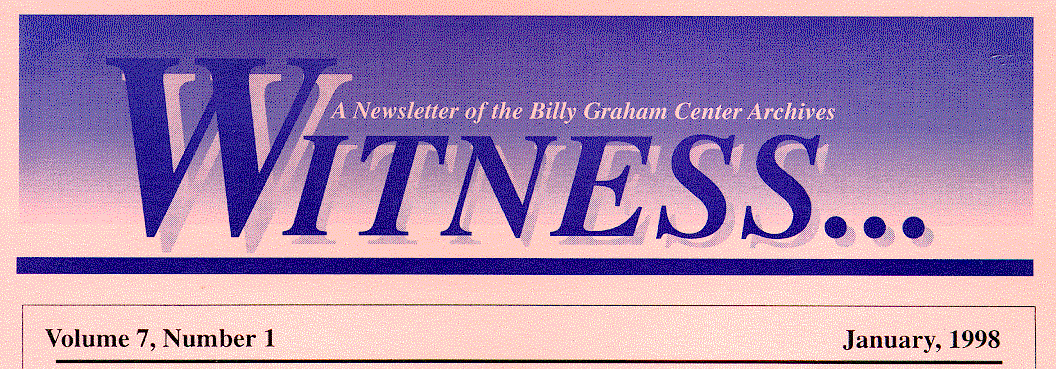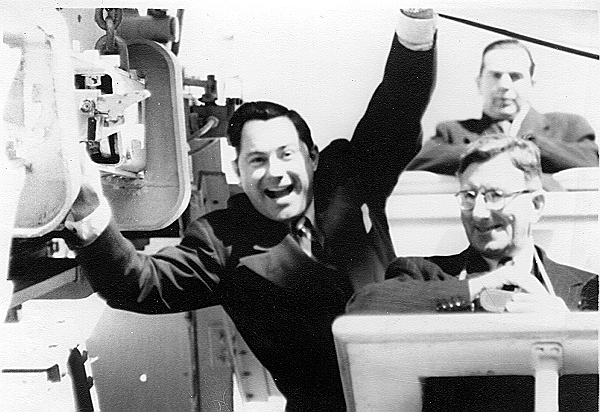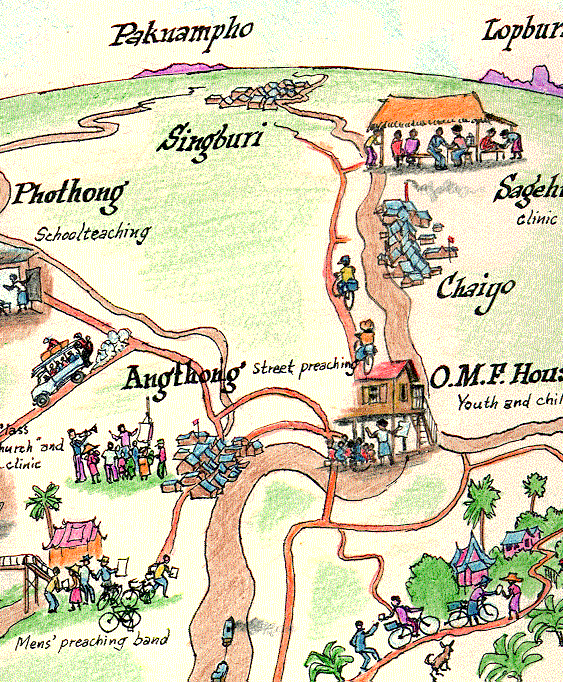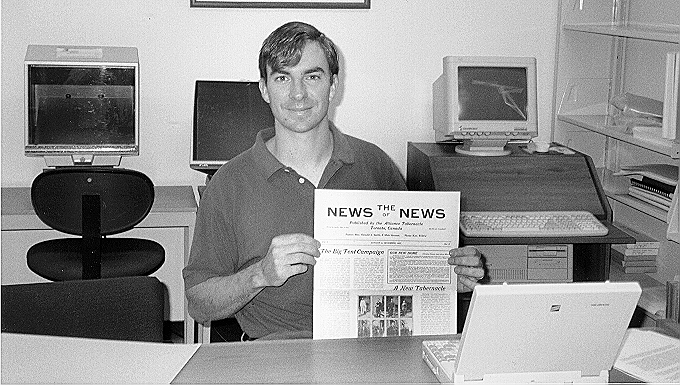
Guides that describe in detail the collections mentioned in this newsletter can accessed through the Archives web site at the New Collections page

Wilson (center, hands raised) , with typical enthusiasm, on the ocean liner United States, sailing to England for the 1954 London Crusade
"I thought I had work to do in Atlanta [at the 1950 evangelistic meetings held in that city], but that wouldn't hold a candle to what they have me doing here in Fort Worth. With several broadcasts a day beginning at 6 o'clock in the morning and with a noon prayer meeting downtown and several high school engagements a day, we are pretty well swamped and can hardly find the time for lunch and dinner.... You might have your folks pray for that closing day that it might be a mighty testimony for Christ out here." Thus wrote Grady Wilson (1919-1987), describing the 1951 Forth Worth, Texas, crusade, one of the Billy Graham Evangelistic Association's early efforts. The expanding outreach of the BGEA would involve meetings around the world which would dwarf these early events in organization, numbers and impact. The story of the BGEA and Wilson's part in it can be traced in Rev. Wilson's papers, Collection 544, which have just been opened.
The collection covers almost four decades (1951-1987) of evangelistic work in North America, Europe, Africa, Asia and the South Pacific. Wilson was on the first board of directors of the BGEA in 1950 and remained one of the key leaders of the Association until his death. His files illustrate the development of the BGEA's ministry over the years - the city-wide evangelistic meetings in medium to large American cities in the early and mid-1950s; the radio, television, film and publishing operations; the expansion of the BGEA to other countries; and the conferences for the training and encouragement of evangelists from around the world. For some campaigns, such as London (1954) and New York City (1957) meetings, the files are especially rich, with correspondence, sermons, minutes, handbills and more that illustrate the planning and impact of the campaigns.
The files in the sixty-seven boxes of the collection show Wilson leading his own campaigns, representing Graham at meetings and in correspondence, heading the BGEA's publishing arm Grason (later World-Wide Publications), and speaking on the Hour of Decision radio program. They also contain the letters Wilson was constantly exchanging with evangelists and other church leaders. Most of these are from the United States, but there is a significant section from other countries. They provide vivid snapshots of the growth of Protestant evangelicalism after World War II.
The collection above all documents a theology
in motion, a faith in action in the world.
Back to Table of Contents

Detail from a one of the items added to Collection 215: A hand drawn map of OMF mission stations in central Thailand in the mid 1970s. OMF photo album file XIV
An archival collection may be viewed as a static body of material, as immobile as if it were etched in stone. But it is more often like a living organism. An evangelistic or mission agency, like any other organization, generates an ongoing trail of correspondence, minutes, reports, photographs, etc. The consequence of this for the Archives is that we receive "new" old materials to add to existing collections. Or a collection can stay the same size but the guide can be expanded to describe it in more detail and thus make it more accessible to researchers. During 1997, the Archives staff arranged and described two of these "additions" to collections, making more current the records of Overseas Missionary Fellowship and the procedure book collection of the Billy Graham Evangelistic Association (BGEA), while expanding the description of the Woman's Union Missionary Society records.
Each volume in the series of BGEA's procedure or sample books (Collection 16) consists of the documents generated for use in a particular crusade (obviously excluding personal correspondence but including form letters, meeting minutes, promotional and public relations pieces, tickets, committee lists, and much more). Each volume is subdivided into sections which reflect the various domains of planning and activity, such as executive committee, counseling and follow-up, and ushers. Although the books were intended for circulation to crusade directors and others as examples of actual crusade practice, their usefulness continues as part of the Archives, because together they document so many BGEA crusades from 1951 to 1982 and offer extensive details about each event. The most recent additions to this series are books from some of the BGEA's earliest meetings (including Seattle in 1951, Detroit in 1953 and New Orleans in 1954), and several more recent crusades (such as the San Jose/Bay Area Crusade in 1981 and the Inland Empire Crusades in 1982).
A more substantial body of material was added to Collection 215, the records of Overseas Missionary Fellowship (OMF). Prior to the addition, OMF's records only extended as far as 1957, whereas they now document activity as recent at 1990. Some of the series in the collection which have been significantly expanded are: 1) the personnel directories; 2) the publications used for promotion and to stimulate prayer (including manuscripts, slide and tape programs, and films); 3) the administrative records documenting the activity and oversight of the mission's U.S. branch; and 4) the correspondence files between the US and the international headquarters. Robert Shuster, who integrated the new materials into the existing collection pointed to the significance of the addition: "For over forty-five years, the mission has been known as Overseas Missionary Fellowship, but the records available to researchers were almost entirely limited to the China-focused, pre 1950 part of its history when it was known as China Inland Mission. The historical record available in OMF's documents now more accurately and comprehensively reflects its work throughout Southeast Asia."
A different type of growth occurred to make the records of the Woman's Union Missionary Society (WUMS) more available to researchers. During the 1997 spring semester, Beth Tebbe (a grad student in Wheaton College Graduate School's Mission/Intercultural Studies program) took a portion of the WUMS guide which had only very briefly described the contents of the collection and expanded the information to include more detailed explanations about the Society's work in China, India, Japan, Nepal and Pakistan. Associate Director Paul Ericksen oversaw Tebbe's work and commented, "While no new material came into the collection, the benefit of Beth's work is that material that was already here is now much more available to interested researchers, giving a clearer view of the WUMS work." As part of her project, Tebbe transformed two paragraphs in the guide which generally described the work in India into an extended description of the types of documents and the nature of the information in them for each of the sites of the mission's work in that country. Ericksen added, "Not all collections deserve this kind of detailed description, but the WUMS records are frequently used by Archives patrons, so expanding the description was not a luxury but our response to the heavy demand for the collection."
The updated versions of the collection guides are available
through the Archives Web Page. See below to learn how to access them. Back to Table of Contents

Kevin Kee holding up some of the material he discovered in the Oswald
Smith collection.
The projects and interests that bring people to the Archives have always shown a fascinating variety. Here are a few from the last few months.
***
Phyllis E. Alsdurf, a Ph.D. student at the University of Minnesota, visited the Archives in May 1997 to study the materials in the Archives on the Evangelical press. As she told the staff, "I came with a general interest in the history of the religious press vis a vis pictorial social events. I chose to focus on one particular event: the "Catholic Issue" in the presidential election of 1960. Ultimately my focus may be upon Christianity Today and its position with regard to Kennedy's Catholicism." She looked at the collections of Billy Graham (Collection 74); Christianity Today International (Collection 8), L. Nelson Bell (Collection 318), and the Billy Graham Center (Collection 3). When asked if she found what she needed, she replied "Yes -- and more so." She also added, "The introductory video was very helpful in getting me oriented.... It was generally a very pleasant research experience."
***
Cathy D. Mellett, a writer whose home is in Michigan, visited the Archives in June 1997 to renew her acquaintance with evangelist Kathryn Kuhlman. "I am working on a novel set in the late fifties/early sixties," she said, "and Kathryn Kuhlman will be a character in the book. I knew her when I was a child, and it was extremely helpful to `see' her once again -- and to be reminded of the era in which she lived and preached, through the films, clippings, etc., available in your Archives."
The bulk of the Kuhlman television programs have been placed in the Archives and are open to anyone who would like to come here to see them. There are also about two thousand audio tapes (many of which are sound tracks from the videos). There are also a number of interviews, both on audio and video, with Kuhlman. Other collections also contain information about her, including the unedited text of an interview about her life
***
Canadian researcher Kevin Kee came to the Archives in July 1997. As part of his research on continuities and discontinuities in Canadian evangelicalism from the 1880s to the 1950s (the subject of his dissertation at the Queens University in Kingston), he was interested in material on Oswald Smith, evangelist, author and founder of the People's Church of Toronto (originally the People's Tabernacle).
"Successful leaders of popular religion are so in part because they have borrowed from the popular culture in a way that helps them express their message. Smith represents someone whose understanding of advertising and gift for promotion was able to further his work." said Kee.
He visited the BGC Archives because Smith's papers are here but was pleasantly surprised by the additional material he found in the BGC Library. About his work in the Archives he said, "I did not find anything that provided a lighting bolt of new inspiration but much material that reinforced the ideas I had already formed from research elsewhere." He has also gathered material from the National Archives of Canada, the Archives of the United Church of Christ of Canada, and Ontario Bible College. The publications of Smith's churches were particularly helpful in mapping out his emphases and showing how they changed over time in such areas as healing , and prophecy. His understanding and use of promotional material seems to have changed dramatically after his stay in Los Angeles in 1927 and 1928, when he observed Bob Shuler and Aimee Semple McPherson.
Besides finding new facts, there was another respect in which the material was new to him "Although my family grew up in the People's Church and I often heard them describe Smith, I was able to actually hear and see him for the first time here, thanks to the phonograph records, film and audio tapes in the Archives."
***
Dr. John A. Gration is a professor emeritus of Wheaton College and former associate director of Africa Inland Mission (AIM). In October he brought Jill and Raymond Davis, a couple who served as missionaries in Africa, to the Reading Room. They wanted to see the diaries of Elwood Linnell Davis (Collection 452), who was Raymond's grandfather and a pioneer missionary under AIM.
Their daughter, Patty-Leigh Davis had come to the Archives in January to look at this same material plus a folder from the AIM records in Collection 81. At a family reunion in the summer they had talked about the records in the Archives and looked at documents such as personal diplomas that had been returned by the Archives to the family.
On their visit in October, the Davises had a chance to see for themselves what was here. They studied with great care and interest two photo albums and several diaries, finding much that was meainful for them. Mrs. Davis found photos of a building that has been torn down on the campus of Rift Valley Academy and ordered copies made for an exhibit to be put up there. They reminisced about people and places in the photographs and left reluctantly.
Any day in the Reading Room there might be someone tracing
family history, or working on a class assignment, a or putting together a
documentary, and or seeking inspiration from from the recordings of Gospel sermons.
It is always a wonder to see the varied benefits living people can discover
in these documents from the past.
Back to Table of Contents
The Archives of the Billy Graham Center is a department of Wheaton College which collects and makes available documents on the part nondenominational Protestant efforts have played in the spread of the Christian Gospel.
Robert Shuster, Director and editor
Paul A. Ericksen, Associate Director
Janyce Nasgowitz, Reference Archivist
Wayne D. Weber, Archival Coordinator
For further information or to subscribe to the newsletter free of charge, please contact us by mail, phone or e-mail.